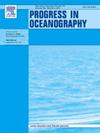锋和暖流作为中国东部陆架海冬季生物聚集热点的声学证据
IF 3.6
3区 地球科学
Q1 OCEANOGRAPHY
引用次数: 0
摘要
海洋生物热点对维持生态系统和海洋生物资源至关重要。然而,仅靠遥感和站样不能充分捕捉到海面下详细的生物聚集模式,特别是在动态和迅速变化的陆架-海环境中。东部陆架海(ECSS)冬季生产力高,不同水团形成强锋。越冬环境的适宜性(温暖和高营养)直接影响种群的补充动态。我们的目标是在2019/2020冬季使用声散射层(SSL)作为ECSS生物热点的指标。此外,采用广义加性模型(GAMs)研究了非生物因子对SSL指标的影响。结果表明:(1)陆相层流主要分布在锋面和暖流区,在锋面暖侧生物聚集较多;(2)远岸暖水区陆桥深度日变化更为明显;(3)两周声波强度变化,以满月春潮为中心,在春潮期间声波观测生物量大于小潮。与遥感相比,声学可以有效地捕捉到看不见的水下生物聚集的热点。这些发现提供了锋面和暖流作为生物聚集热点的声学证据,增强了我们从水声角度对聚集与海洋生物地球物理过程之间关系的理解。本文章由计算机程序翻译,如有差异,请以英文原文为准。
Acoustic evidence of fronts and warm currents as hotspots for biological aggregation in the winter Eastern China shelf Sea
Marine organism hotspots are critical for sustaining ecosystems and marine biological resources. However, remote sensing and station sampling alone cannot fully capture the detailed biological aggregation patterns beneath the sea surface, particularly in dynamic and rapidly shifting shelf-sea environments. The Eastern China Shelf Sea (ECSS) exhibits high productivity during winter, with strong fronts formed by different water masses. The suitability of the overwintering environment (warm and high nutrient) directly influences population recruitment dynamics. We aimed to use the sound scattering layer (SSL) as an indicator of biological hotspots in the ECSS during the winter of 2019/2020. Additionally, Generalized Additive Models (GAMs) were employed to investigate the effects of abiotic factors on SSL metrics. Our findings include: (1) The SSL was primarily located in the frontal and warm-current regions, with greater biological aggregation on the warm side of the front; (2) Diurnal variations in SSL depth were more pronounced in far shore warm water zones; (3) Fortnightly SSL variability, with SSL occurrences centered around the full moon spring tide, and greater acoustically observed biomass during spring tide than neap tide. In contrast to remote sensing, acoustics effectively captures hotspots of unseen underwater organism aggregation. These findings provide acoustic evidence that fronts and warm currents serve as hotspots for biological aggregation, enhancing our understanding of the relationship between aggregation and ocean biogeophysical processes from an underwater acoustic perspective.
求助全文
通过发布文献求助,成功后即可免费获取论文全文。
去求助
来源期刊

Progress in Oceanography
地学-海洋学
CiteScore
7.20
自引率
4.90%
发文量
138
审稿时长
3 months
期刊介绍:
Progress in Oceanography publishes the longer, more comprehensive papers that most oceanographers feel are necessary, on occasion, to do justice to their work. Contributions are generally either a review of an aspect of oceanography or a treatise on an expanding oceanographic subject. The articles cover the entire spectrum of disciplines within the science of oceanography. Occasionally volumes are devoted to collections of papers and conference proceedings of exceptional interest. Essential reading for all oceanographers.
 求助内容:
求助内容: 应助结果提醒方式:
应助结果提醒方式:


